Integrated Porosity Classification and Quantification Scheme for Enhanced Carbonate Reservoir Quality: Implications from the Miocene Malaysian Carbonates
Abstract
:1. Introduction
2. Limitations of Existing Porosity Classifications and their Texture
Porosity Classifications
3. Application of Macro-Micro Classification from Miocene Carbonates
Material and Methods
4. Results and Discussion
4.1. Facies Analysis
4.2. Pore Types
4.3. Quantification of Macro-Microporosity
4.4. Effect of Microporosity on Petrophysical Properties
5. Conclusions
Author Contributions
Funding
Institutional Review Board Statement
Informed Consent Statement
Acknowledgments
Conflicts of Interest
References
- Janjuhah, H.T.; Alansari, A. Offshore carbonate facies characterization and reservoir quality of miocene rocks in the southern margin of south china sea. Acta Geol. Sin. 2020, 94, 1547–1561. [Google Scholar] [CrossRef]
- Lambert, L.; Durlet, C.; Loreau, J.-P.; Marnier, G. Burial dissolution of micrite in Middle East carbonate reservoirs (Jurassic–Cretaceous): Keys for recognition and timing. Mar. Pet. Geol. 2006, 23, 79–92. [Google Scholar] [CrossRef]
- Pal, S.; Mushtaq, M.; Banat, F.; Al Sumaiti, A.M. Review of surfactant-assisted chemical enhanced oil recovery for carbonate reservoirs: Challenges and future perspectives. Pet. Sci. 2018, 15, 77–102. [Google Scholar] [CrossRef] [Green Version]
- Akbar, M.; Vissapragada, B.; Alghamdi, A.H.; Allen, D.; Herron, M.; Carnegie, A.; Dutta, D.; Olesen, J.-R.; Chourasiya, R.; Logan, D. A snapshot of carbonate reservoir evaluation. Oilfield Rev. 2000, 12, 20–21. [Google Scholar]
- Han, M.; AlSofi, A.; Fuseni, A.; Zhou, X.; Hassan, S. Development of Chemical EOR Formulations for a High Temperature and High Salinity Carbonate Reservoir. In Proceedings of the IPTC 2013: International Petroleum Technology Conference, Beijing, China, 26–28 March 2013; European Association of Geoscientists & Engineers: Houten, The Netherlands, 2013; p. cp-350-00486. [Google Scholar]
- Burchette, T.P. Carbonate rocks and petroleum reservoirs: A geological perspective from the industry. Geol. Soc. Lond. Spec. Publ. 2012, 370, 17–37. [Google Scholar] [CrossRef]
- Perrin, C.; Marquez, X.; Flores, J.; Berthereau, G. Porosity depth saturation (PDS) model: Quantification of porosity preservation with burial in carbonate oil reservoirs, and application to infer oil charging time. Mar. Pet. Geol. 2020, 120, 104515. [Google Scholar] [CrossRef]
- Yang, L.; Shenghe, W.; Jiagen, H.; Jianmin, L. Progress and prospects of reservoir development geology. Pet. Explor. Dev. 2017, 44, 603–614. [Google Scholar]
- Janjuhah, H.T.; Alansari, A.; Santha, P.R. Interrelationship between facies association, diagenetic alteration and reservoir properties evolution in the Middle Miocene carbonate build up, Central Luconia, Offshore Sarawak, Malaysia. Arab. J. Sci. Eng. 2019, 44, 341–356. [Google Scholar] [CrossRef]
- Janjuhah, H.T.; Alansari, A.; Vintaned, J.A.G. Quantification of microporosity and its effect on permeability and acoustic velocity in Miocene carbonates, Central Luconia, offshore Sarawak, Malaysia. J. Pet. Sci. Eng. 2019, 175, 108–119. [Google Scholar] [CrossRef]
- Kontakiotis, G.; Karakitsios, V.; Cornée, J.-J.; Moissette, P.; Zarkogiannis, S.D.; Pasadakis, N.; Koskeridou, E.; Manoutsoglou, E.; Drinia, H.; Antonarakou, A. Preliminary results based on geochemical sedimentary constraints on the hydrocarbon potential and depositional environment of a Messinian sub-salt mixed siliciclastic-carbonate succession onshore Crete (Plouti section, eastern Mediterranean). Mediterr. Geosci. Rev. 2020, 2, 247–265. [Google Scholar] [CrossRef]
- Janjuhah, H.T.; Sanjuan, J.; Alquadah, M.; Salah, M.K. Biostratigraphy, depositional and diagenetic processes in carbonate rocks form southern Lebanon: Impact on porosity and permeability. Acta Geol. Sin. 2021, 5, 1668–1683. [Google Scholar] [CrossRef]
- Regnet, J.-B.; Fortin, J.; Nicolas, A.; Pellerin, M.; Guéguen, Y. Elastic properties of continental carbonates: From controlling factors to an applicable model for acoustic-velocity predictions. Geophysics 2019, 84, MR45–MR59. [Google Scholar] [CrossRef]
- Janjuhah, H.T.; Salim, A.M.A.; Alansari, A.; Ghosh, D.P. Presence of microporosity in Miocene carbonate platform, Central Luconia, offshore Sarawak, Malaysia. Arab. J. Geosci. 2018, 11, 204. [Google Scholar] [CrossRef]
- Peng, S. Gas relative permeability and its evolution during water imbibition in unconventional reservoir rocks: Direct laboratory measurement and a conceptual model. SPE Reserv. Eval. Eng. 2019, 22, 1346–1359. [Google Scholar] [CrossRef]
- Bashir, Y.; Babasafari, A.A.; Biswas, A.; Hamidi, R.; Moussavi Alashloo, S.Y.; Tariq Janjuah, H.; Prasad Ghosh, D.; Weng Sum, C. Cohesive Approach for High-Resolution Seismic Using Inversion & Imaging in Malaysian Carbonate Field. In Proceedings of the International Petroleum Technology Conference, Beijing, China, 26–28 March 2019. [Google Scholar]
- Janjuhah, H.T.; Salim, A.; Mohammad, A.; Ali, M.Y.; Ghosh, D.P.; Hassan, A.; Hakif, M. Development of Carbonate Buildups and Reservoir Architecture of Miocene Carbonate Platforms, Central Luconia, Offshore Sarawak, Malaysia. In Proceedings of the SPE/IATMI Asia Pacific Oil & Gas Conference and Exhibition, Jakarta, Indonesia, 17–19 October 2017. [Google Scholar]
- Norbisrath, J.H.; Weger, R.J.; Eberli, G.P. Complex resistivity spectra and pore geometry for predictions of reservoir properties in carbonate rocks. J. Pet. Sci. Eng. 2017, 151, 455–467. [Google Scholar] [CrossRef]
- Kontakiotis, G.; Moforis, L.; Karakitsios, V.; Antonarakou, A. Sedimentary facies analysis, reservoir characteristics and paleogeography significance of the early jurassic to eocene carbonates in epirus (Ionian Zone, Western Greece). J. Mar. Sci. Eng. 2020, 8, 706. [Google Scholar] [CrossRef]
- Chacko, S.; Fainstein, R.; Li, C. Introduction to this special section: Southeast Asia. Lead. Edge 2020, 39, 541–542. [Google Scholar] [CrossRef]
- Janjuhah, H.T.; Alansari, A.; Ghosh, D.P.; Bashir, Y. New approach towards the classification of microporosity in Miocene carbonate rocks, Central Luconia, offshore Sarawak, Malaysia. J. Nat. Gas Geosci. 2018, 3, 119–133. [Google Scholar] [CrossRef]
- Folk, R.L. Practical petrographic classification of limestones. AAPG Bull. 1959, 43, 1–38. [Google Scholar]
- Dunham, R.J. Classification of carbonate rocks according to depositional textures. Am. Assoc. Pet. Geol. 1962, 1, 108–121. [Google Scholar]
- Embry, A.F.; Klovan, J.E. A late Devonian reef tract on northeastern Banks Island, NWT. Bull. Can. Pet. Geol. 1971, 19, 730–781. [Google Scholar]
- Wardlaw, N. Pore geometry of carbonate rocks as revealed by pore casts and capillary pressure. AAPG Bull. 1976, 60, 245–257. [Google Scholar]
- Choquette, P.W.; Pray, L.C. Geologic nomenclature and classification of porosity in sedimentary carbonates. AAPG Bull. 1970, 54, 207–250. [Google Scholar]
- Moore, C.H. Carbonate Diagenesis and Porosity; Elsevier: Amsterdam, The Netherlands, 1989; Volume 46. [Google Scholar]
- Maliva, R.G. Carbonate Facies Models and Diagenesis. In Aquifer Characterization Techniques; Springer: Berlin/Heidelberg, Germany, 2016; pp. 91–110. [Google Scholar]
- Fabricius, I.L.; Røgen, B.; Gommesen, L. How depositional texture and diagenesis control petrophysical and elastic properties of samples from five North Sea chalk fields. Pet. Geosci. 2007, 13, 81–95. [Google Scholar] [CrossRef] [Green Version]
- Fabricius, I.L.; Bächle, G.T.; Eberli, G.P. Elastic moduli of dry and water-saturated carbonates—Effect of depositional texture, porosity, and permeability. Geophysics 2010, 75, N65–N78. [Google Scholar] [CrossRef]
- Baechle, G.T.; Colpaert, A.; Eberli, G.P.; Weger, R.J. Effects of microporosity on sonic velocity in carbonate rocks. Lead. Edge 2008, 27, 1012–1018. [Google Scholar] [CrossRef]
- Anselmetti, F.S.; Eberli, G.P. Controls on Sonic Velocity in Carbonates. In Experimental Techniques in Mineral and Rock Physics; Springer: Berlin/Heidelberg, Germany, 1993; pp. 287–323. [Google Scholar]
- Melim, L.A.; Anselmetti, F.S.; Eberli, G.P. The importance of pore type on permeability of Neogene carbonates, Great Bahama Bank. In Subsurface Geology of a Prograding Carbonate Platform Margin, Great Bahama Bank: Results of the Bahamas Drilling Project; SEPM: Tulsa, OK, USA, 2001; Volume 70, pp. 217–238. [Google Scholar]
- Anselmetti, F.S.; Eberli, G.P. The velocity-deviation log: A tool to predict pore type and permeability trends in carbonate drill holes from sonic and porosity or density logs. AAPG Bull. 1999, 83, 450–466. [Google Scholar]
- Weger, R.J.; Eberli, G.P.; Baechle, G.T.; Massaferro, J.L.; Sun, Y.-F. Quantification of pore structure and its effect on sonic velocity and permeability in carbonates. AAPG Bull. 2009, 93, 1297–1317. [Google Scholar] [CrossRef]
- Kumar, M.; Han, D.-h. Pore Shape Effect on Elastic Properties of Carbonate Rocks. In Proceedings of the 2005 SEG Annual Meeting; Society of Exploration Geophysicists: Huston, TX, USA, 2005. [Google Scholar]
- Fitch, P.J.; Lovell, M.A.; Davies, S.J.; Pritchard, T.; Harvey, P.K. An integrated and quantitative approach to petrophysical heterogeneity. Mar. Pet. Geol. 2015, 63, 82–96. [Google Scholar] [CrossRef] [Green Version]
- Lucia, F.J. Rock-fabric/petrophysical classification of carbonate pore space for reservoir characterization. Am. Assoc. Pet. Geol. 1995, 79, 1275–1300. [Google Scholar]
- Anselmetti, F.S.; Eberli, G.P. Sonic Velocity in Carbonate—A Product of Original Composition and Postdepositional Porosity Evolution: Ann: AAPG-SEPMEMD-DPA-CSPG; Conv. Abstracts; American Association of Petroleum Geologists: Tulsa, OK, USA, 1992. [Google Scholar]
- Pittman, E.D. Relationship of porosity and permeability to various parameters derived from mercury injection-capillary pressure curves for sandstone (1). AAPG Bull. 1992, 76, 191–198. [Google Scholar]
- Cantrell, D.L.; Hagerty, R.M. Microporosity in Arab formation carbonates, Saudi Arabia. GeoArabia 1999, 4, 129–154. [Google Scholar] [CrossRef]
- Lønøy, A. Making sense of carbonate pore systems. AAPG Bull. 2006, 90, 1381–1405. [Google Scholar] [CrossRef]
- Lucia, F.; Loucks, R. Microporosity in carbonate mud: Early development and petrophysics. Gulf Coast Assoc. Geol. Socities 2013, 2, 1275–1300. [Google Scholar]
- Jobe, T.; Sarg, J. Microporosity Characterization of Mud-Rich Carbonate Rocks. In Pore Scale Phenomena: Frontiers in Energy and Environment; World Scientific: Singapore, 2015; pp. 67–89. [Google Scholar]
- Archie, G.E. Classification of carbonate reservoir rocks and petrophysical considerations. Aapg Bull. 1952, 36, 278–298. [Google Scholar]
- Tucker, M.E.; Wright, V.P. Carbonate Sedimentology; John Wiley & Sons: New York, NY, USA, 2009. [Google Scholar]
- Wilson, J.C.; McBride, E.F. Compaction and porosity evolution of Pliocene sandstones, Ventura Basin, California. AAPG Bull. 1988, 72, 664–681. [Google Scholar]
- Wilson, M.E. Global and regional influences on equatorial shallow-marine carbonates during the Cenozoic. Palaeogeogr. Palaeoclimatol. Palaeoecol. 2008, 265, 262–274. [Google Scholar] [CrossRef]
- Scholle, P.A.; Ulmer-Scholle, D.S. A Color Guide to the Petrography of Carbonate Rocks: Grains, Textures, Porosity, Diagenesis, AAPG Memoir 77; AAPG: Tulsa, OK, USA, 2003; Volume 77. [Google Scholar]
- Al-Dabbas, M.; Al-Jassim, J.; Al-Jumaily, S. Depositional environments and porosity distribution in regressive limestone reservoirs of the Mishrif Formation, Southern Iraq. Arab. J. Geosci. 2010, 3, 67–78. [Google Scholar] [CrossRef]
- Purser, B.; Brown, A.; Aissaoui, D. Nature, Origin and Evolution of Porosity in Dolomites. In Dolomites: A Volume in Honour of Dolomieu; Purser, B., Tucker, M., Zenger, D., Eds.; Special Publication; International Association of Sedimentologists: Algiers, Algeria, 1994; pp. 283–308. [Google Scholar]
- Xi, K.; Cao, Y.; Jahren, J.; Zhu, R.; Bjørlykke, K.; Haile, B.G.; Zheng, L.; Hellevang, H. Diagenesis and reservoir quality of the Lower Cretaceous Quantou Formation tight sandstones in the southern Songliao Basin, China. Sediment. Geol. 2015, 330, 90–107. [Google Scholar] [CrossRef]
- Madden, R.H.; Wilson, M.E. Diagenesis of a SE Asian Cenozoic carbonate platform margin and its adjacent basinal deposits. Sediment. Geol. 2013, 286, 20–38. [Google Scholar] [CrossRef]
- Wilson, J.L. Carbonate Facies in Geologic History; Springer Science & Business Media: Berlin/Heidelberg, Germany, 2012. [Google Scholar]
- Lucia, F. Petrophysical parameters estimated from visual descriptions of carbonate rocks: A field classification of carbonate pore space. J. Pet. Technol. 1983, 35, 629–637. [Google Scholar] [CrossRef]
- Rahman, M.H.; Pierson, B.J.; Yusoff, W.; Ismail, W. Classification of Microporosity in Carbonates: Examples from Miocene Carbonate Reservoirs of Central Luconia, Offshore Sarawak, Malaysia. In Proceedings of the International Petroleum Technology Conference; European Association of Geoscientists & Engineers: Houten, The Netherlands, 2011. [Google Scholar]
- Rahman, M.H.; Pierson, B.J. Effects of Microporosity on Permeability and Sonic Velocity of Miocene Carbonates and an Approach to Relate Micrite Microtextures with Microporosity Occurrences in Miocene Carbonate Reservoirs of Offshore Sarawak, Malaysia. In SEG Technical Program Expanded Abstracts 2011; Society of Exploration Geophysicists: Tulsa, OK, USA, 2011; pp. 2059–2063. [Google Scholar]
- Nole, M.; Daigle, H.; Milliken, K.L.; Prodanović, M. A method for estimating microporosity of fine-grained sediments and sedimentary rocks via scanning electron microscope image analysis. Sedimentology 2016, 63, 1507–1521. [Google Scholar] [CrossRef]
- Kaczmarek, S.E.; Fullmer, S.M.; Hasiuk, F.J. A universal classification scheme for the microcrystals that host limestone microporosity. J. Sediment. Res. 2015, 85, 1197–1212. [Google Scholar] [CrossRef]
- Wentworth, C.K. A scale of grade and class terms for clastic sediments. J. Geol. 1922, 30, 377–392. [Google Scholar] [CrossRef]
- Janjuhah, H.T.; Salim, A.M.A.; Ghosh, D.P. Sedimentology and reservoir geometry of the Miocene Carbonate deposits in Central Luconia, Offshore, Sarawak, Malaysia. J. Appl. Sci. 2017, 17, 153–170. [Google Scholar] [CrossRef] [Green Version]
- Lucia, F.J. Carbonate Reservoir Characterization: An Integrated Approach; Springer: Berlin/Heidelberg, Germany; New York, NY, USA, 2007. [Google Scholar]
- Zhuravlev, A.Y.; Wood, R.A. Controls on carbonate skeletal mineralogy: Global CO2 evolution and mass extinctions. Geology 2009, 37, 1123–1126. [Google Scholar] [CrossRef]
- Pittman, E.D. Microporosity in carbonate rocks: Geological notes. AAPG Bull. 1971, 55, 1873–1878. [Google Scholar]
- Ong, C.W.; Ho, P.; Leo, H.L. Effects of microporous stent graft on the descending aortic aneurysm: A patient-specific computational fluid dynamics study. Artif. Organs 2016, 40, E230–E240. [Google Scholar] [CrossRef]
- Anselmetti, F.S.; Luthi, S.; Eberli, G.P. Quantitative characterization of carbonate pore systems by digital image analysis. Am. Assoc. Pet. Geol. Bull. 1998, 82, 1815–1836. [Google Scholar]
- Ruzyla, K.; Jezek, D. Staining method for recognition of pore space in thin and polished sections: Research method paper. J. Sediment. Res. 1987, 57, 777–778. [Google Scholar] [CrossRef]
- Yanguas, J.; Dravis, J.J. Blue fluorescent dye technique for recognition of microporosity in sedimentary rocks: Research method paper. J. Sediment. Res. 1985, 55, 600–602. [Google Scholar]
- Milliken, K.L.; Curtis, M.E. Imaging pores in sedimentary rocks: Foundation of porosity prediction. Mar. Pet. Geol. 2016, 73, 590–608. [Google Scholar] [CrossRef] [Green Version]
- Arribas, M.; Bustillo, A.; Tsige, M. Lacustrine chalky carbonates: Origin, physical properties and diagenesis (Palaeogene of the Madrid Basin, Spain). Sediment. Geol. 2004, 166, 335–351. [Google Scholar] [CrossRef] [Green Version]
- Cox, P.; Wood, R.; Dickson, J.; Al Rougha, H.; Shebl, H.; Corbett, P. Dynamics of cementation in response to oil charge: Evidence from a Cretaceous carbonate field, UAE. Sediment. Geol. 2010, 228, 246–254. [Google Scholar] [CrossRef]
- Flugel, E. Microfacies of Carbonate Rocks: Analysis, Interpretation and Application; Springer: Berlin/Heidelberg, Germany; New York, NY, USA, 2004; p. 979. [Google Scholar]
- Kaldi, J. Diagenetic microporosity (chalky porosity), middle Devonian Kee Scarp reef complex, Norman wells, northwest territories, Canada. Sediment. Geol. 1989, 63, 241–252. [Google Scholar] [CrossRef]
- Volery, C.; Davaud, E.; Foubert, A.; Caline, B. Lacustrine microporous micrites of the Madrid Basin (Late Miocene, Spain) as analogues for shallow-marine carbonates of the Mishrif reservoir Formation (Cenomanian to Early Turonian, Middle East). Facies 2010, 56, 385–397. [Google Scholar] [CrossRef] [Green Version]
- Morad, D.; Paganoni, M.; Al Harthi, A.; Morad, S.; Ceriani, A.; Mansurbeg, H.; Al Suwaidi, A.; Al-Aasm, I.S.; Ehrenberg, S.N. Origin and evolution of microporosity in packstones and grainstones in a Lower Cretaceous carbonate reservoir, United Arab Emirates. Geol. Soc. Lond. Spec. Publ. 2016, 435, 47–66. [Google Scholar] [CrossRef]
- Van Geet, M.; Swennen, R.; Durmishi, C.; Roure, F.; Muchez, P. Paragenesis of Cretaceous to Eocene carbonate reservoirs in the Ionian fold and thrust belt (Albania): Relation between tectonism and fluid flow. Sedimentology 2002, 49, 697–718. [Google Scholar] [CrossRef]
- Ehrenberg, S. Porosity destruction in carbonate platforms. J. Pet. Geol. 2006, 29, 41–52. [Google Scholar] [CrossRef]
- Yu, Y.; Visser, F.; Amro, M.M. Quantitative Effect of Microporosity on Permeability in Carbonate Reservoirs. In Proceedings of the International Petroleum Technology Conference, Kuala Lumpur, Malaysia, 10–12 December 2014. [Google Scholar]
- Okabe, H.; Blunt, M. Predicting Permeability through 3D Pore-Space Images Reconstructed Using Multiple-Point Statistics. In Proceedings of the International Symposium of the Society of Core Analysts, Abu Dhabi, United Arab Emirates, 5–9 October 2004; pp. 5–9. [Google Scholar]
- Chehrazi, A.; Rezaee, R. A systematic method for permeability prediction, a Petro-Facies approach. J. Pet. Sci. Eng. 2012, 82–83, 1–16. [Google Scholar] [CrossRef]
- Shah, S.; Yang, J.; Crawshaw, J.P.; Gharbi, O.; Boek, E.S. Predicting Porosity and Permeability of Carbonate rocks from Core-scale to Pore-Scale using Medical CT, Confocal Laser Scanning Microscopy and Micro CT. In Proceedings of the SPE Annual Technical Conference and Exhibition, New Orleans, LS, USA, 20 September–2 October 2013. [Google Scholar]
- Silin, D.B.; Patzek, T.W. Predicting Relative-Permeability Curves Directly from Rock Images. In Proceedings of the SPE Annual Technical Conference and Exhibition, New Orleans, LS, USA, 4–7 October 2009. [Google Scholar]
- Archie, G.E. The electrical resistivity log as an aid in determining some reservoir characteristics. Trans. AIME 1942, 146, 54–62. [Google Scholar] [CrossRef]
- Clerke, E.A.; Mueller, H.; Phillips, E.C.; Eyvazzadeh, R.Y.; Jones, D.H.; Ramamoorthy, R.; Srivastava, A. Application of Thomeer Hyperbolas to decode the pore systems, facies and reservoir properties of the Upper Jurassic Arab D Limestone, Ghawar field, Saudi Arabia: A “Rosetta Stone” approach. GeoArabia 2008, 13, 113–160. [Google Scholar] [CrossRef]
- Moshier, S.O. Development of microporosity in a micritic limestone reservoir, Lower Cretaceous, Middle East. Sediment. Geol. 1989, 63, 217–240. [Google Scholar] [CrossRef]
- Domingo, C.; García-Carmona, J.; Loste, E.; Fanovich, A.; Fraile, J.; Gómez-Morales, J. Control of calcium carbonate morphology by precipitation in compressed and supercritical carbon dioxide media. J. Cryst. Growth 2004, 271, 268–273. [Google Scholar] [CrossRef]
- Periere, M.D.; Durlet, C.; Vennin, E.; Lambert, L.; Bourillot, R.; Caline, B.; Poli, E. Morphometry of micrite particles in cretaceous microporous limestones of the Middle East: Influence on reservoir properties. Mar. Pet. Geol. 2011, 28, 1727–1750. [Google Scholar] [CrossRef]

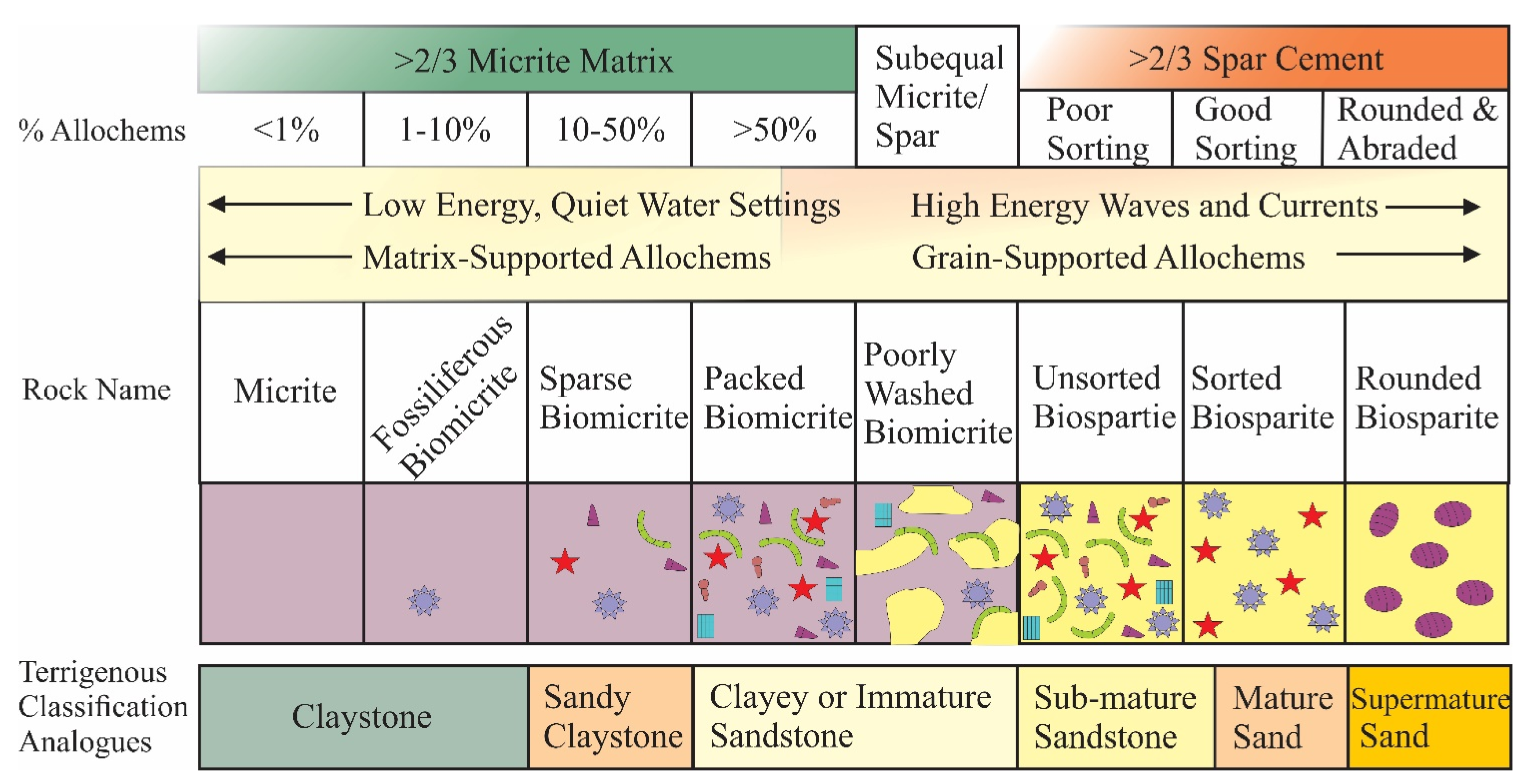
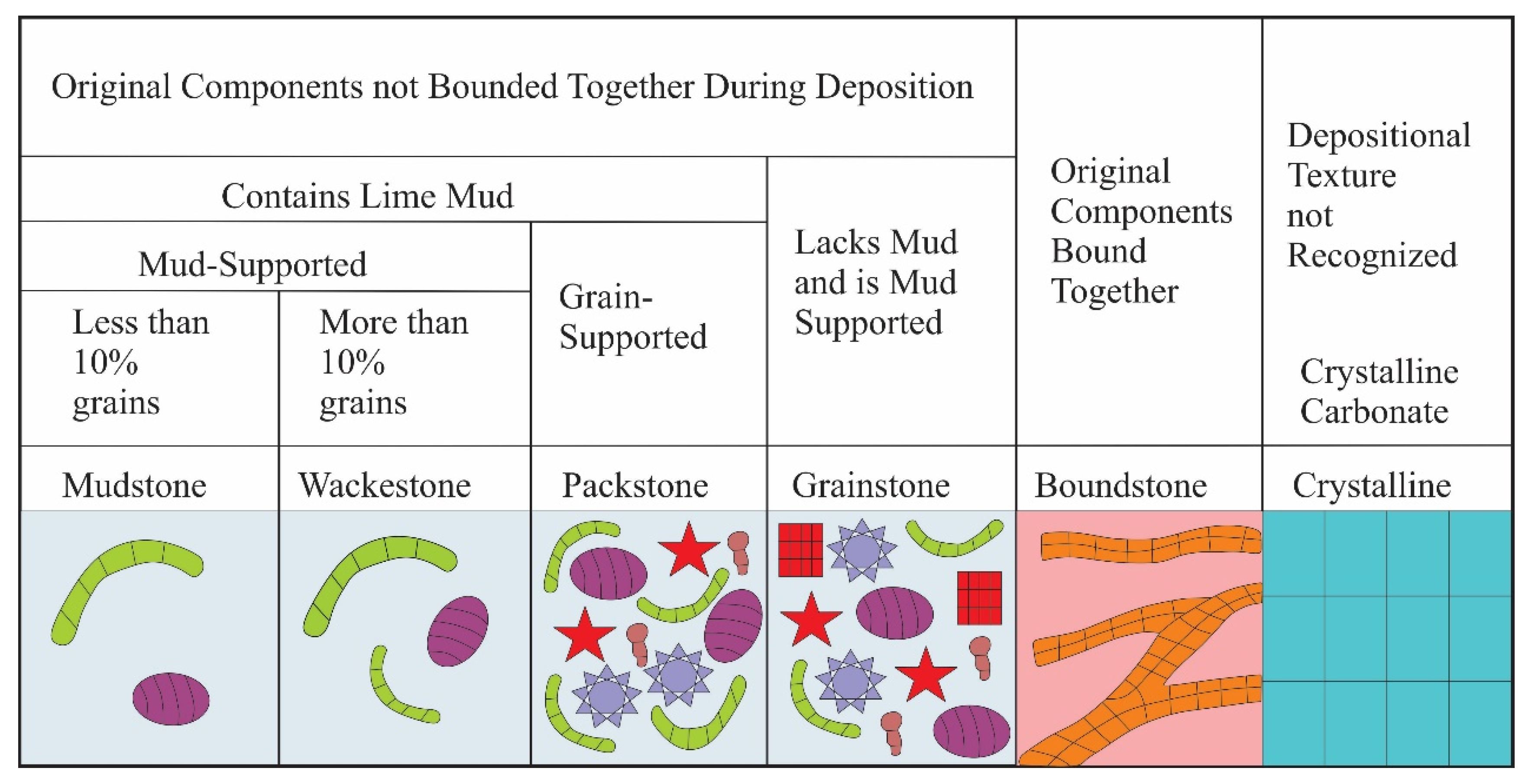
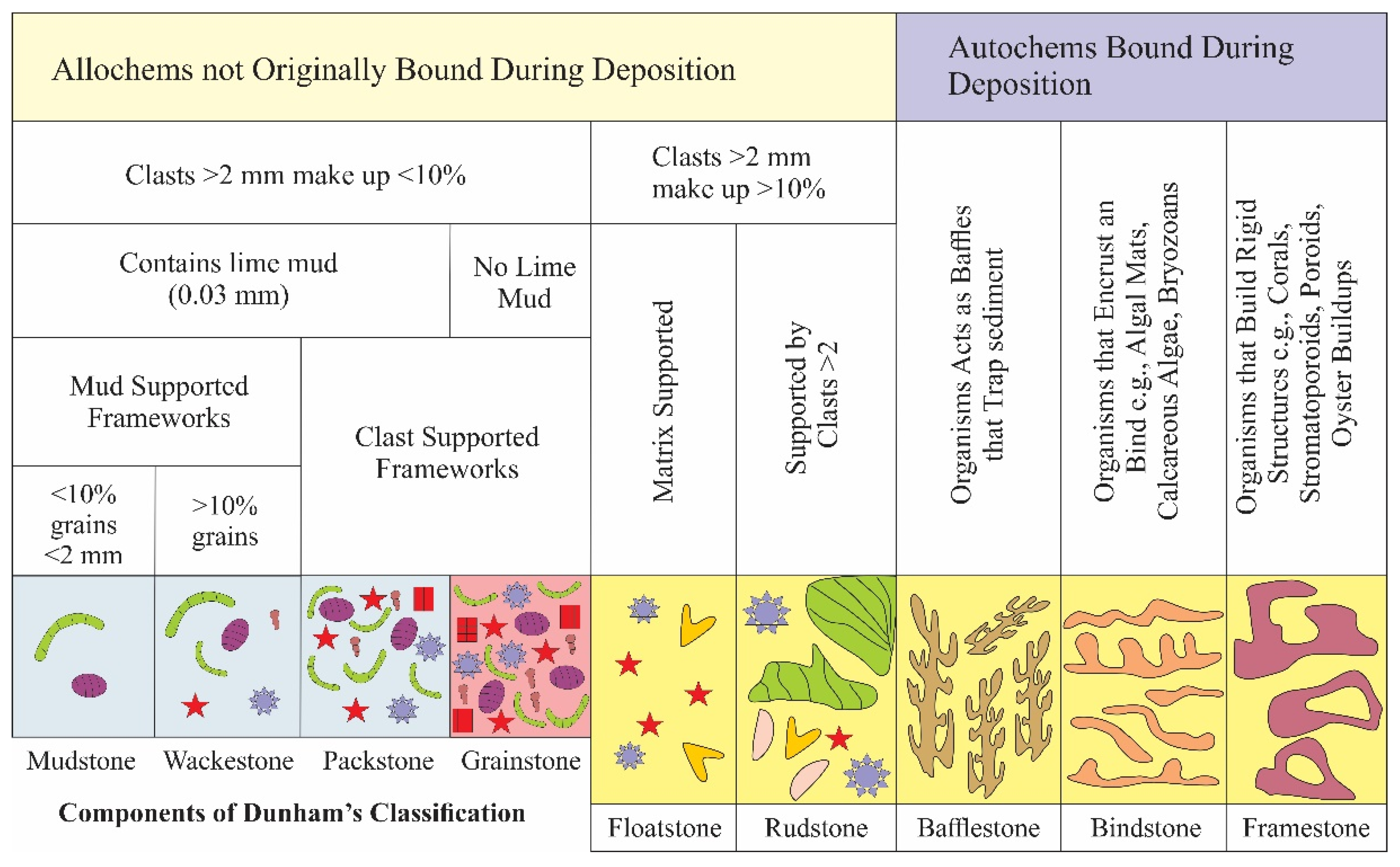
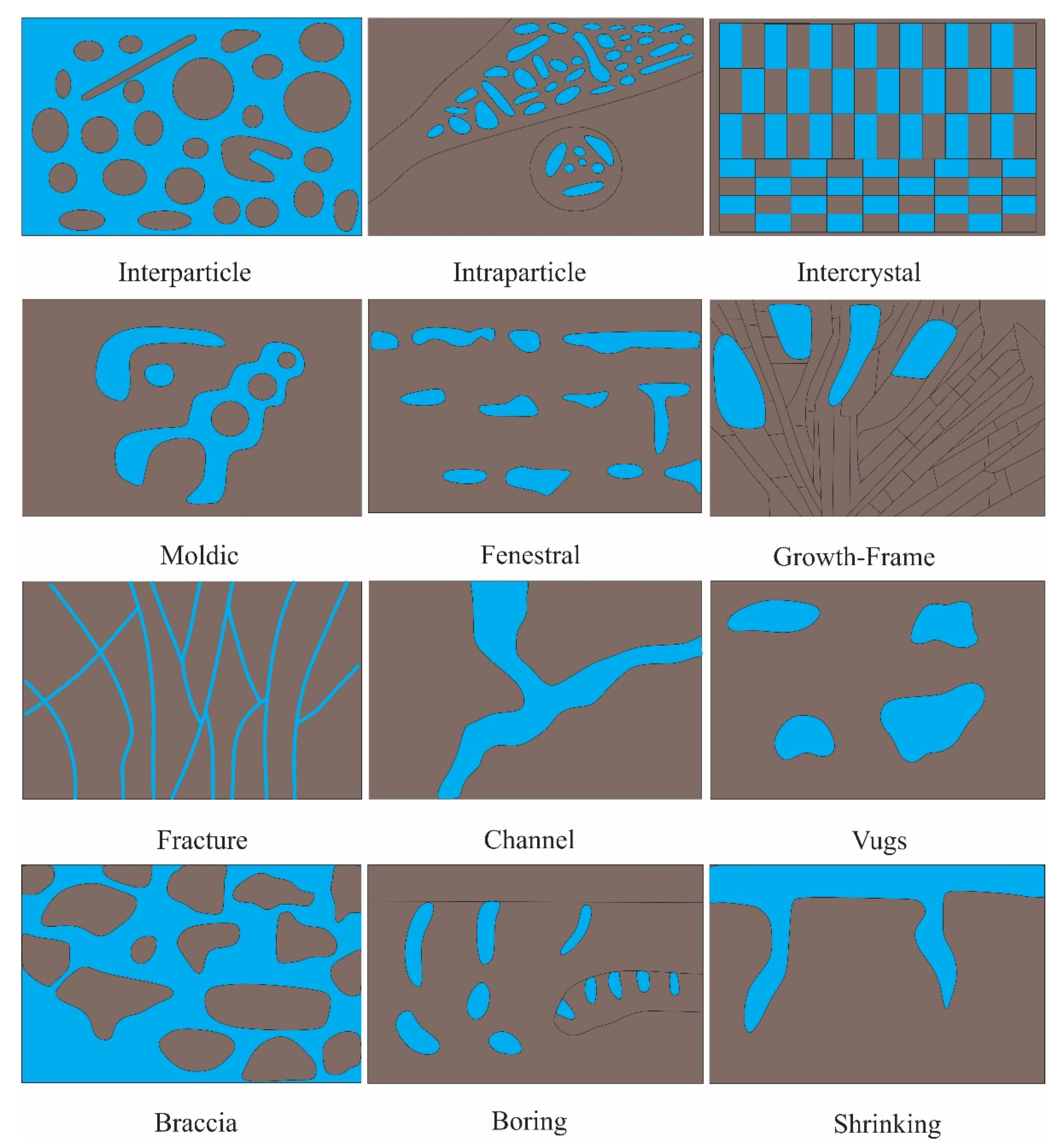

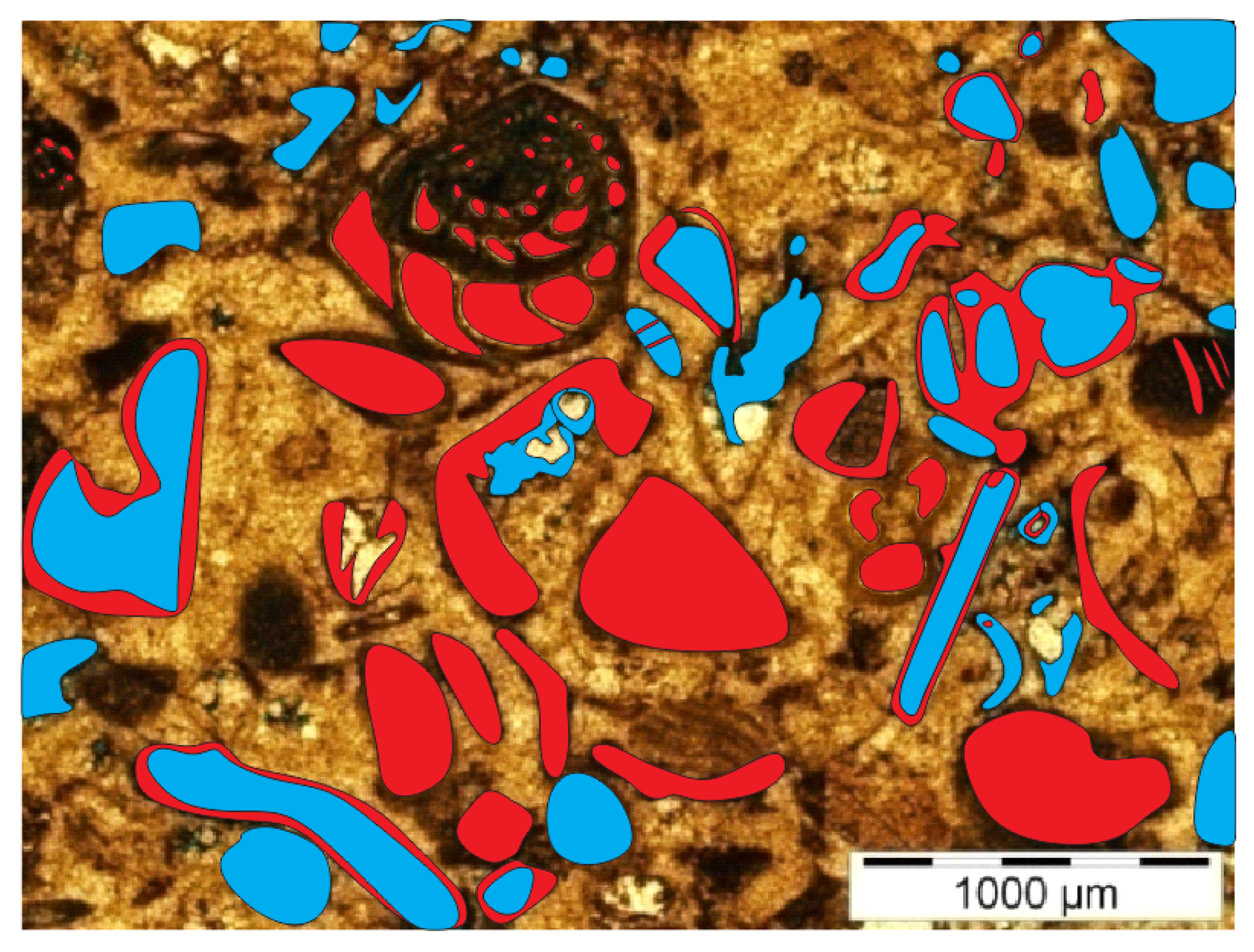

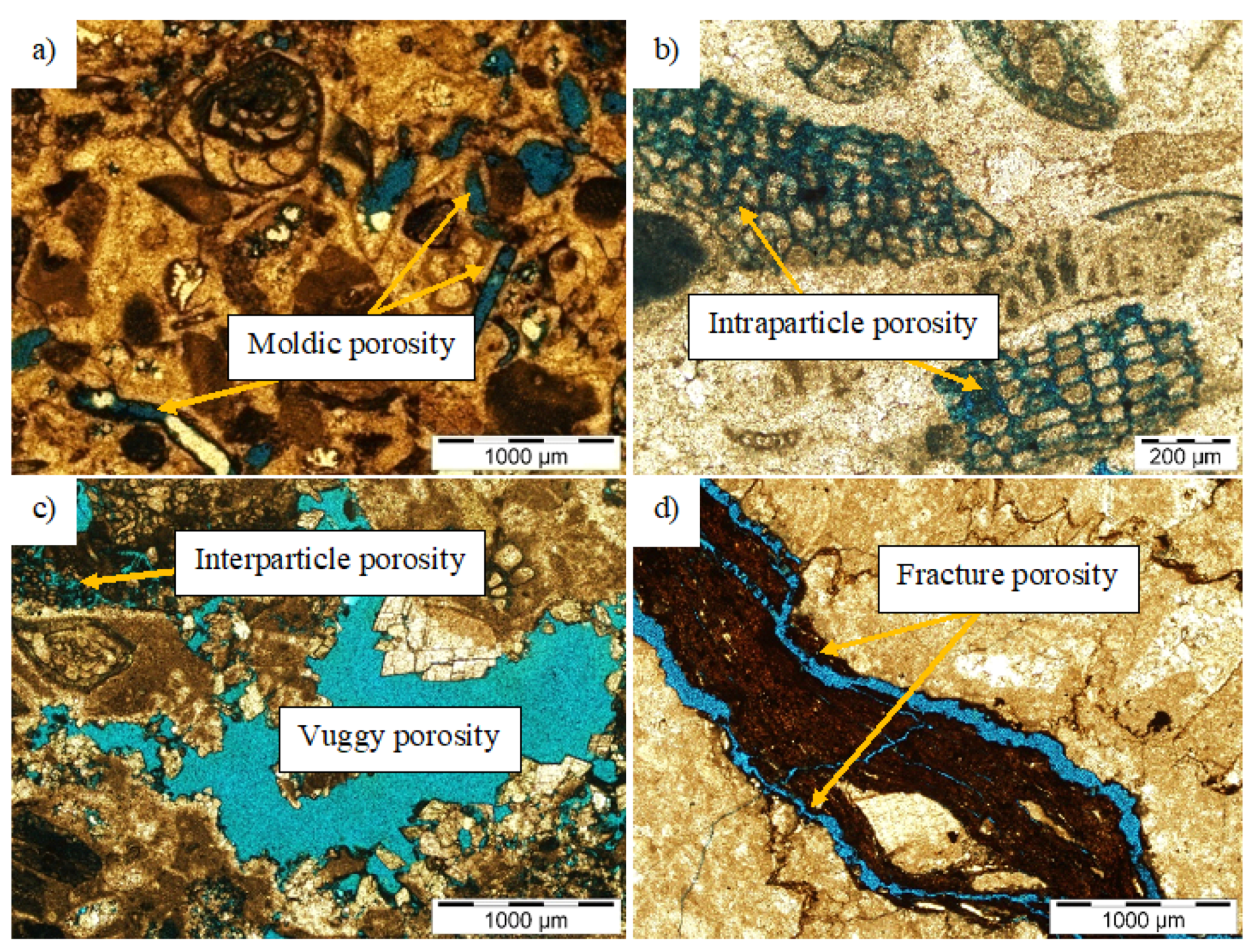


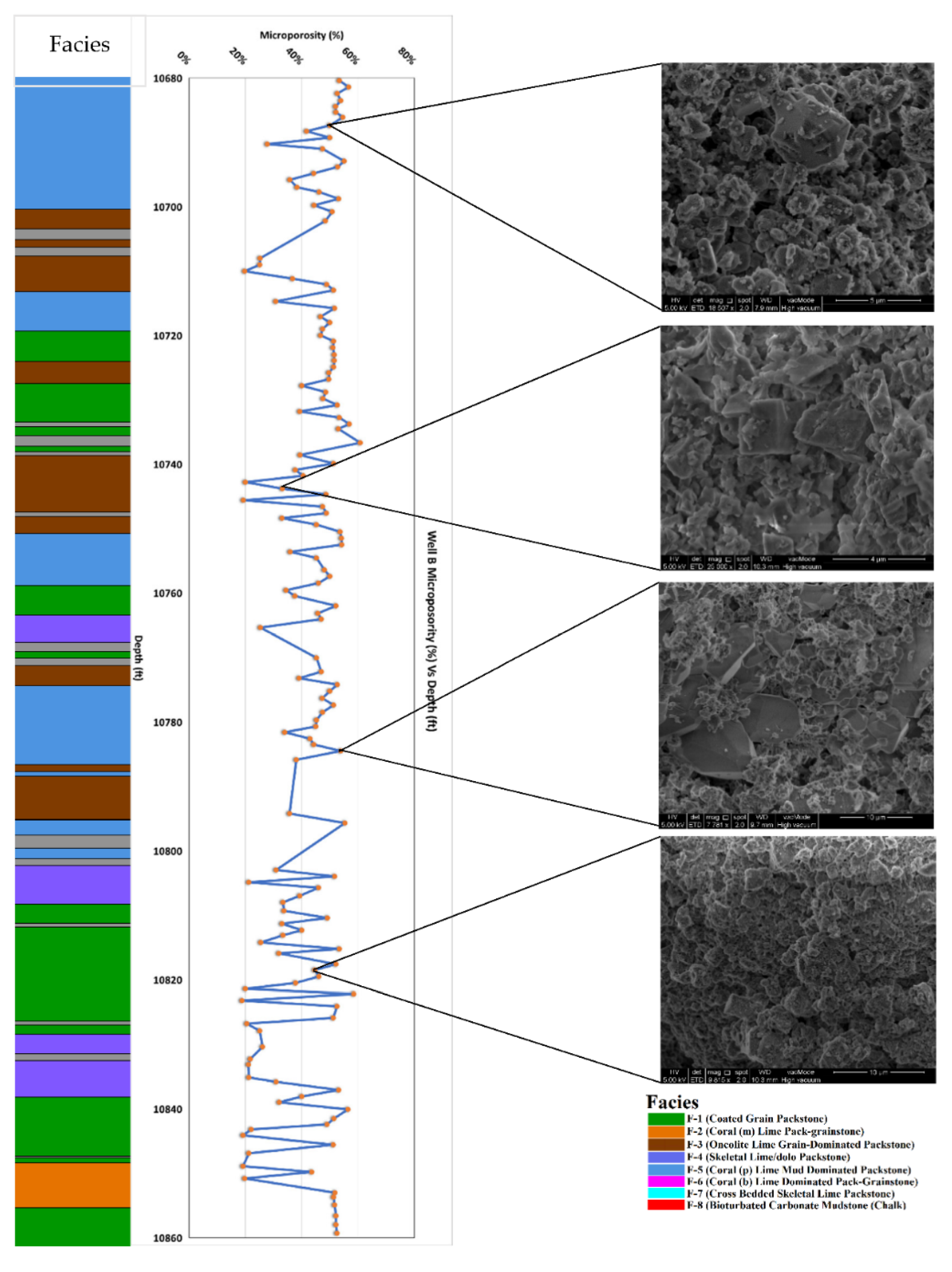
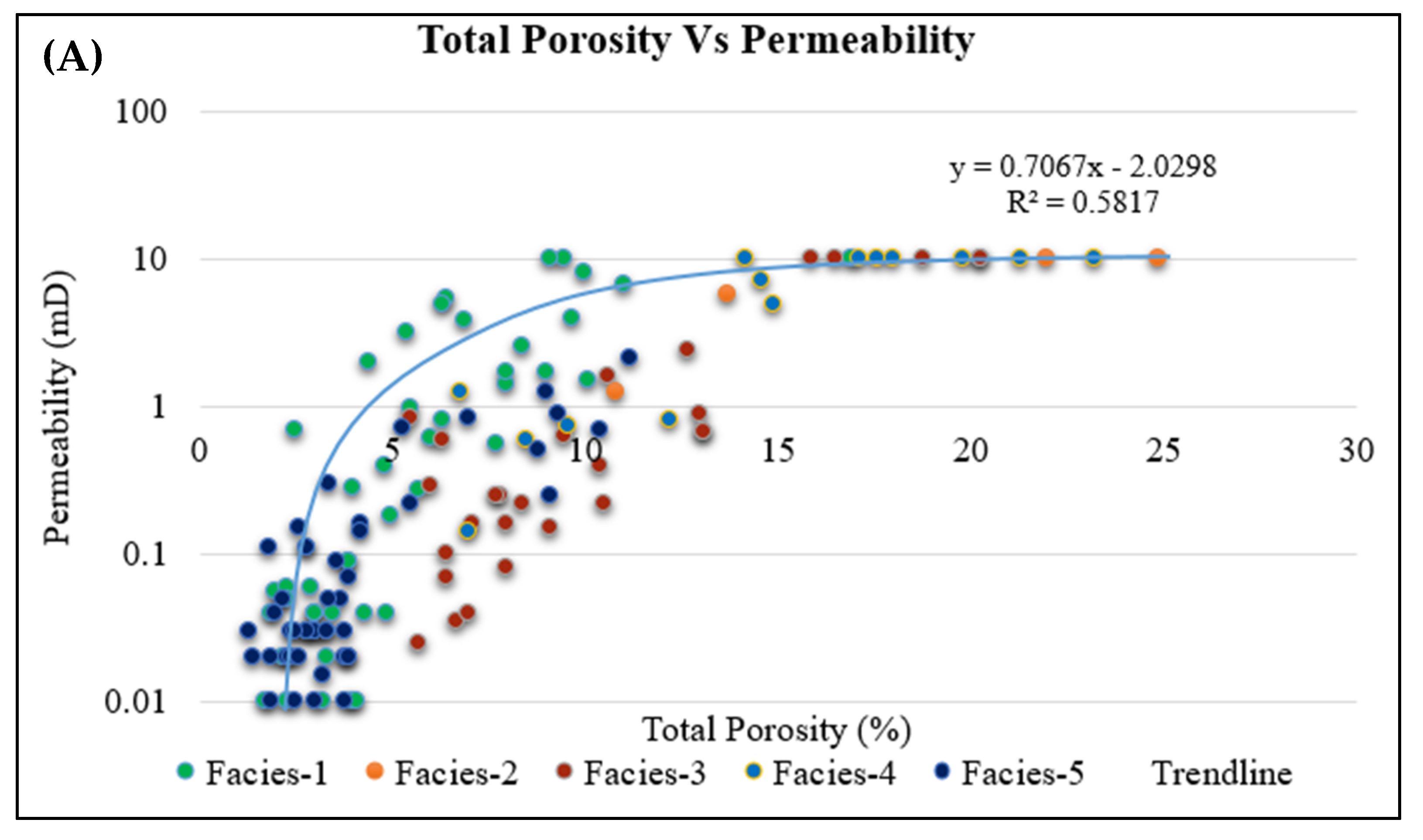
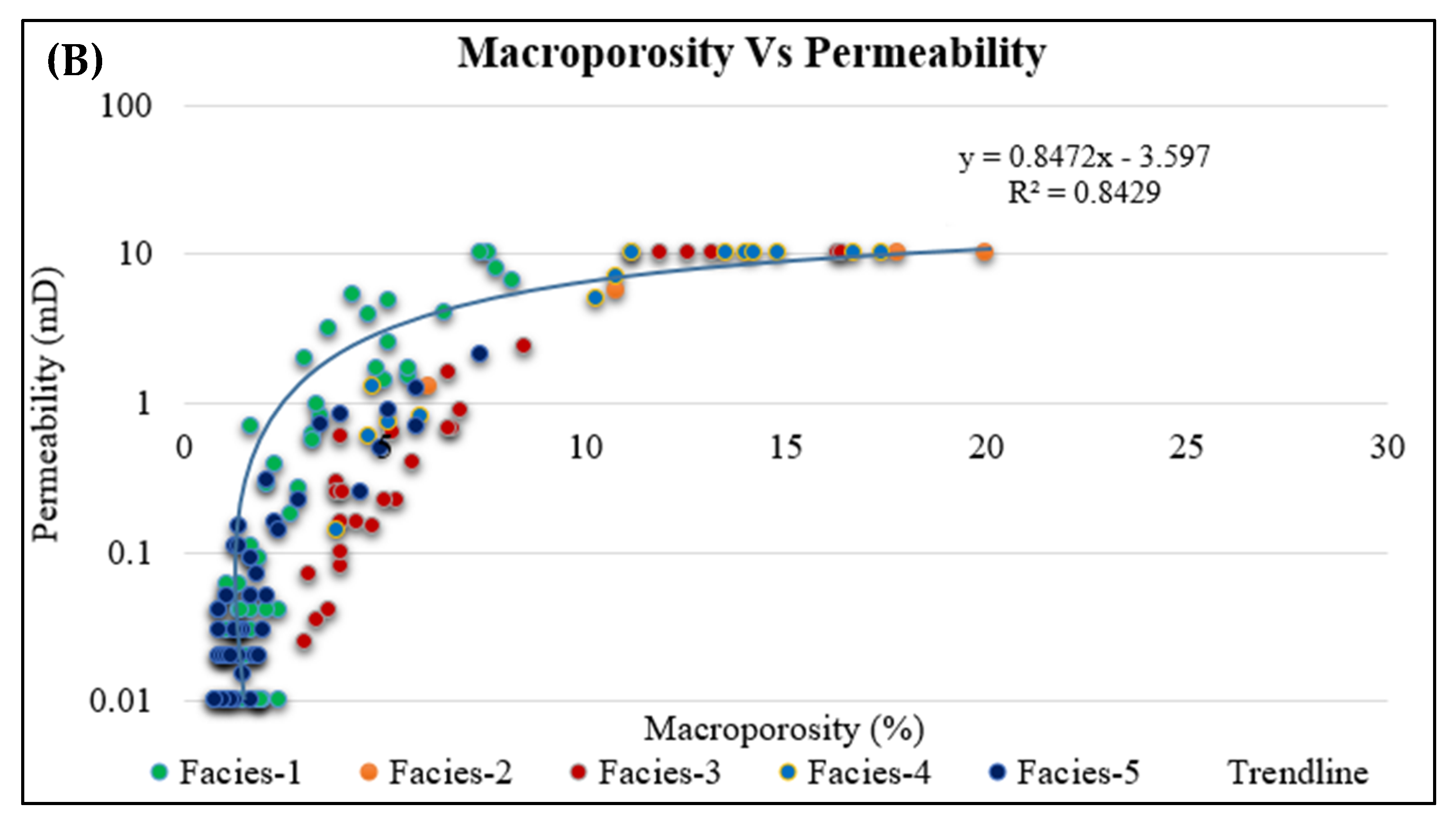
| Matrix Texture | Hand Sample Appearance | Microscopic Appearance |
|---|---|---|
| Type-I Compact Crystalline | Edges and surfaces that are both sharp and smooth. | The splitting of clusters of crystals in thin flanks produces “feather edges” in a matrix made up of crystals weakly interacting but with no obvious pore spaces between them. |
| Type-II Chalky | The small crystals are less closely interlocked and hence reflect light in diverse directions, or, because the material is composed of very fine granules, a dull, chalky, crystalline appearance is missing. | Less interlocking crystals interlock at various angles. This may cause a chalky texture, although others may become crystalline. |
| Type-III Granular | Sugary appearance (Sucrose). Very fine: 0.05 mm, Fine: 0.1 mm, Medium: 0.2 mm, Coarse: 0.4 mm. | Crystals interlocking at varying angles, allowing for significant porosity between crystals. This includes oolitic textures. |
| Class | Description |
|---|---|
| Class A | Pores smaller than 0.01 mm in diameter, not visible with a 10× resolution microscope. |
| Class B | Greater than or equal to 0.01 mm of visible porosity |
| Class C | More than 0.1 mm of visible porosity, however, the mess is less than the size of the cuttings |
| Class D | Secondary crystal development on the cutting surfaces, or “weathered-appearing” faces displaying signs of fracture or solution channels, is an indication of visible porosity. |
| Interparticle | Between the grains, there is a space. The permeability and recovery of sand are generally excellent. Porosity and permeability are reduced due to the use of interparticle cement. |
| Intraparticle | Within particles, there is an area known as a pore space. The pore size and permeability of a fossil chamber, such as a foram’s chamber, or a coral microstructure, determines its porosity and permeability. Water or oil in smaller pore networks may be irreducible. |
| Intercrystalline | Between the crystals of recrystallized limestone, there is porosity. The most prevalent kind of porosity in dolomites, which are often very porous and permeable reservoirs. If present in chalk mudstone, porosity may be significant due to the presence of a large amount of irreducible water, whereas permeability will be low until fractured. |
| Moldic | Porosity occurs when skeletal and non-skeletal grains leach. Effective porosity and permeability are determined by the texture, the degree to which grains leach, and the quantity of interparticle cement. Generally inefficient porosity and poor permeability when just isolated pore types are present, but great when inter-crystal or interparticle pore types are present. |
| Fracture | Porosity formed by the brittle deformation of rock. Porosity is usually low, but permeability will be higher. |
| Vugs | Porosity formed by an enlargement of fabric-selective pore such as moldic and intraskeletal pores. |
| Channel | Porosity formed by enlarged dissolution of early formed pore system. |
| Core Description Sheet | Grain Size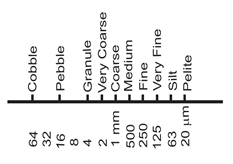 | Lithology | Depositional Texture | Leaching | Stylolite Frequency | Visual Porosity Distribution |
| Resources | Wentworth [60] | HCL, Grain Density | Dunham [23] (Figure 4) | Visual Observation | Park, 1968 | Visual Observation |
| Lithofacies | Description | |
|---|---|---|
| FA-1 Coated Grain Packstone | 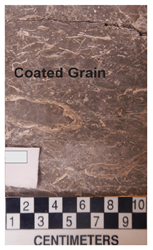 | Texture: packstone (floatstone) Mineralogy: limestone Components: algae >50%, oncolite algae <40%, corals <30%, separate vugs, skeletal debris (angular—subangular), forams, echinoderms, gastropods, leaching Grain size/sorting: fine-medium gravel/moderately—poor |
| FA-2 Coral (m) Lime Pack-Grainstone | 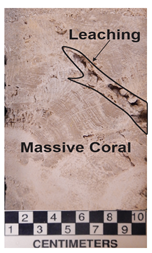 | Texture: packstone–grainstone (rudstone) Mineralogy: limestone Components: corals (m) >50% (up to 8 cm in diameter), platy coral up to 20%, branching corals (15%), solitary coral <5%, algae, disconnected vugs, oncolite algae, skeletal grains (angular-subangular), gastropods, bivalves, echinoid spines Grain size/sorting: very coarse-granule/moderately poor |
| FA-3 Oncolite Lime Grain-dominated Packstone | 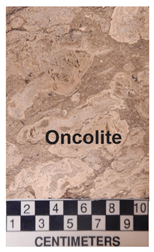 | Texture: packstone (rudstone) Mineralogy: limestone Components: oncolite algae >70% (diameter 2 to 6 cm), stylolite, corals >30%, separate vugs, algae, gastropods, bivalves, echinoid spines, skeletal grains (angular-subangular), leaching Grain size/sorting: medium-gravel/ moderately poor |
| FA-4 Skeletal Lime/dolo Packstone | 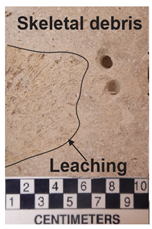 | Texture: packstone (floatstone-rudstone) Mineralogy: limestone—dolomitic limestone Components: skeletal debris >60% (angular-subangular), bivalves, isolated gastropods, corals (m) <20%, Coral (p) <15%, leaching Grain size/sorting: fine-coarse grain/ moderately well sorted |
| FA-5 Coral (p) Lime Mud dominated Packstone |  | Texture: packstone (floatstone) Mineralogy: limestone Components: rich platy corals >70%, solitary coral up to 15%, algae, small fractures, disconnected small vugs, skeletal debris (angular-subangular), gastropod, forams, echinoid spines Grain size/sorting: fine-coarse/poor |
| FA-6 Coral (B) Lime dominated Pack-Grainstone | 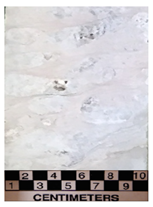 | Texture: packstone-grainstone (floatstone) Mineralogy: limestone-dolomitic limestone Components: branching coral 50%, 20% red algae, 15% forams, 5% massive coral, 5% bivalve, 5% other skeletal debris (angular-subangular) Grain size/sorting: very coarse-granule/poor |
| FA-7 Cross Bedded Skeletal Lime Packstone |  | Texture: packstone (floatstone) Mineralogy: dolomitic limestone to limestone Structures: graded bedding Components: forams 65%, red algae 10%, coral fragments 10%, bivalve 5%, echinoderms 5%, other skeletal debris 5% Grain size/sorting: very coarse-pebble/poorly or moderately sorted |
| FA-8 Bioturbated Carbonate Mud stone (Chalk) | 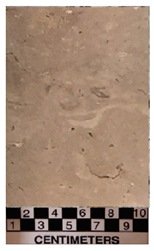 | Texture: wackstone—packstone Mineralogy: dolomitic limestone Structures: bioturbation Components: burrowing & bioturbation 60%, forams 10%, coral debris 10%, red algae 5% Grain size/sorting: very fine-coarse/ moderately well sorted |
Publisher’s Note: MDPI stays neutral with regard to jurisdictional claims in published maps and institutional affiliations. |
© 2021 by the authors. Licensee MDPI, Basel, Switzerland. This article is an open access article distributed under the terms and conditions of the Creative Commons Attribution (CC BY) license (https://creativecommons.org/licenses/by/4.0/).
Share and Cite
Janjuhah, H.T.; Kontakiotis, G.; Wahid, A.; Khan, D.M.; Zarkogiannis, S.D.; Antonarakou, A. Integrated Porosity Classification and Quantification Scheme for Enhanced Carbonate Reservoir Quality: Implications from the Miocene Malaysian Carbonates. J. Mar. Sci. Eng. 2021, 9, 1410. https://doi.org/10.3390/jmse9121410
Janjuhah HT, Kontakiotis G, Wahid A, Khan DM, Zarkogiannis SD, Antonarakou A. Integrated Porosity Classification and Quantification Scheme for Enhanced Carbonate Reservoir Quality: Implications from the Miocene Malaysian Carbonates. Journal of Marine Science and Engineering. 2021; 9(12):1410. https://doi.org/10.3390/jmse9121410
Chicago/Turabian StyleJanjuhah, Hammad Tariq, George Kontakiotis, Abdul Wahid, Dost Muhammad Khan, Stergios D. Zarkogiannis, and Assimina Antonarakou. 2021. "Integrated Porosity Classification and Quantification Scheme for Enhanced Carbonate Reservoir Quality: Implications from the Miocene Malaysian Carbonates" Journal of Marine Science and Engineering 9, no. 12: 1410. https://doi.org/10.3390/jmse9121410
APA StyleJanjuhah, H. T., Kontakiotis, G., Wahid, A., Khan, D. M., Zarkogiannis, S. D., & Antonarakou, A. (2021). Integrated Porosity Classification and Quantification Scheme for Enhanced Carbonate Reservoir Quality: Implications from the Miocene Malaysian Carbonates. Journal of Marine Science and Engineering, 9(12), 1410. https://doi.org/10.3390/jmse9121410










